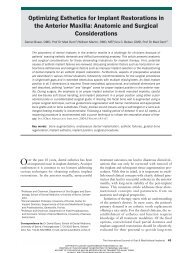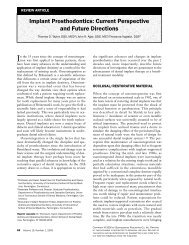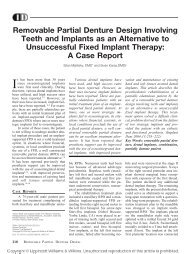Load Transfer by an implant in a sinus-grafted Maxillary ... - Id-sc.com
Load Transfer by an implant in a sinus-grafted Maxillary ... - Id-sc.com
Load Transfer by an implant in a sinus-grafted Maxillary ... - Id-sc.com
You also want an ePaper? Increase the reach of your titles
YUMPU automatically turns print PDFs into web optimized ePapers that Google loves.
FANUSCU ET AL<br />
Figs 10a <strong>an</strong>d 10b Stresses produced <strong>in</strong><br />
model under 13.6-kg axial load when the<br />
stiffness of the simulated graft <strong>in</strong>creased to<br />
its highest level. (Left) Isochromatic fr<strong>in</strong>ge<br />
patterns; (right) diagrammatic representations<br />
of stress <strong>in</strong>tensities.<br />
Figs 11a <strong>an</strong>d 11b Stresses produced <strong>in</strong><br />
model under 13.6-kg <strong>in</strong>cl<strong>in</strong>ed load when<br />
the stiffness of the simulated graft<br />
<strong>in</strong>creased to its highest level. (Left) Isochromatic<br />
fr<strong>in</strong>ge patterns; (right) diagrammatic<br />
representations of stress <strong>in</strong>tensities.<br />
Table 1 Elastic Modulus of Tissues 26,27 <strong>an</strong>d<br />
Simul<strong>an</strong>ts<br />
Elastic<br />
Elastic<br />
modulus<br />
modulus<br />
Bone (GPa) Simul<strong>an</strong>t (GPa)<br />
Cortical 14 PLM-1 2.93<br />
C<strong>an</strong>cellous 1.4 PL-2 0.21<br />
Grafted up to 11 Modified PLM-1 Variable*<br />
*Value varies with age.<br />
<strong>grafted</strong> material is potentially <strong>in</strong>dicative of higher<br />
stiffness. Even though conclusive evidence concern<strong>in</strong>g<br />
the relative mech<strong>an</strong>ical characteristics of graft<br />
<strong>an</strong>d c<strong>an</strong>cellous bone is lack<strong>in</strong>g, this study provides<br />
<strong>an</strong> <strong>in</strong>itial attempt at demonstrat<strong>in</strong>g the <strong>in</strong>teractions<br />
of different quality bones with the loaded impl<strong>an</strong>t.<br />
Further studies utiliz<strong>in</strong>g a more flexible graft simul<strong>an</strong>t<br />
are currently <strong>in</strong> progress.<br />
Photoelastic model<strong>in</strong>g, like all <strong>in</strong> vitro studies<br />
that use model systems, has adv<strong>an</strong>tages <strong>an</strong>d limitations.<br />
The most adv<strong>an</strong>tageous po<strong>in</strong>t of this technique<br />
<strong>in</strong> <strong>com</strong>parison with other methods, such as<br />
f<strong>in</strong>ite element <strong>an</strong>alysis, is the use of actual materials<br />
such as impl<strong>an</strong>ts. On the other h<strong>an</strong>d, as a disadv<strong>an</strong>tage<br />
of this technique, it is currently difficult to<br />
adjust the degree of osseo<strong>in</strong>tegration. A few studies<br />
have been carried out on bone-impl<strong>an</strong>t contact us<strong>in</strong>g<br />
retrieved tit<strong>an</strong>ium microimpl<strong>an</strong>ts from the hum<strong>an</strong><br />
posterior maxilla with <strong>grafted</strong> s<strong>in</strong>uses. 19,29 They<br />
revealed less bone-impl<strong>an</strong>t contact area <strong>in</strong> the<br />
<strong>grafted</strong> bone portion, particularly for impl<strong>an</strong>ts<br />
placed simult<strong>an</strong>eously with a bone graft, th<strong>an</strong> <strong>in</strong> the<br />
native bone portion. Although there is no evidence<br />
of a relationship between the degree of boneimpl<strong>an</strong>t<br />
contact <strong>an</strong>d stress distribution, it c<strong>an</strong> be<br />
hypothesized that potentially much higher magnitudes<br />
of stress might concentrate <strong>in</strong> the native<br />
bone/impl<strong>an</strong>t <strong>in</strong>terface when the <strong>in</strong>terface of the<br />
impl<strong>an</strong>t with <strong>grafted</strong> bone is dim<strong>in</strong>ished. In the photoelastic<br />
model, the impl<strong>an</strong>t was <strong>com</strong>pletely osseo<strong>in</strong>tegrated<br />
<strong>in</strong> both native <strong>an</strong>d <strong>grafted</strong> bone simul<strong>an</strong>ts;<br />
the magnitude of stresses might be different <strong>in</strong> the<br />
cl<strong>in</strong>ical situation. However, the trends of stress distribution<br />
would not be subst<strong>an</strong>tially ch<strong>an</strong>ged. These<br />
trends were effectively demonstrated <strong>in</strong> the <strong>com</strong>plex<br />
model under axial <strong>an</strong>d <strong>in</strong>cl<strong>in</strong>ed loads.<br />
The results of this study <strong>in</strong>dicated that higher<br />
stresses occurred <strong>in</strong> the stiffer bone simul<strong>an</strong>ts<br />
672 Volume 18, Number 5, 2003





